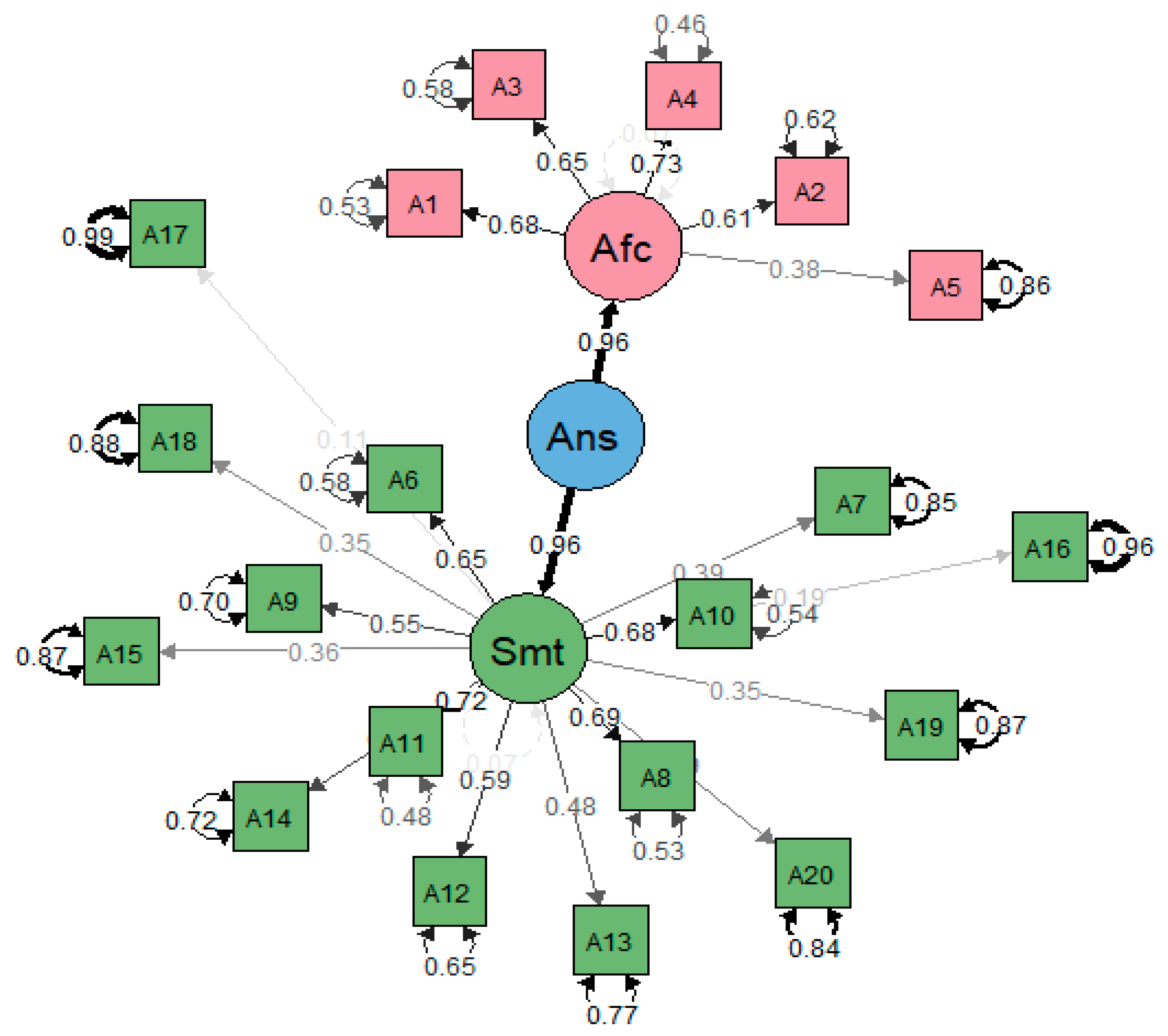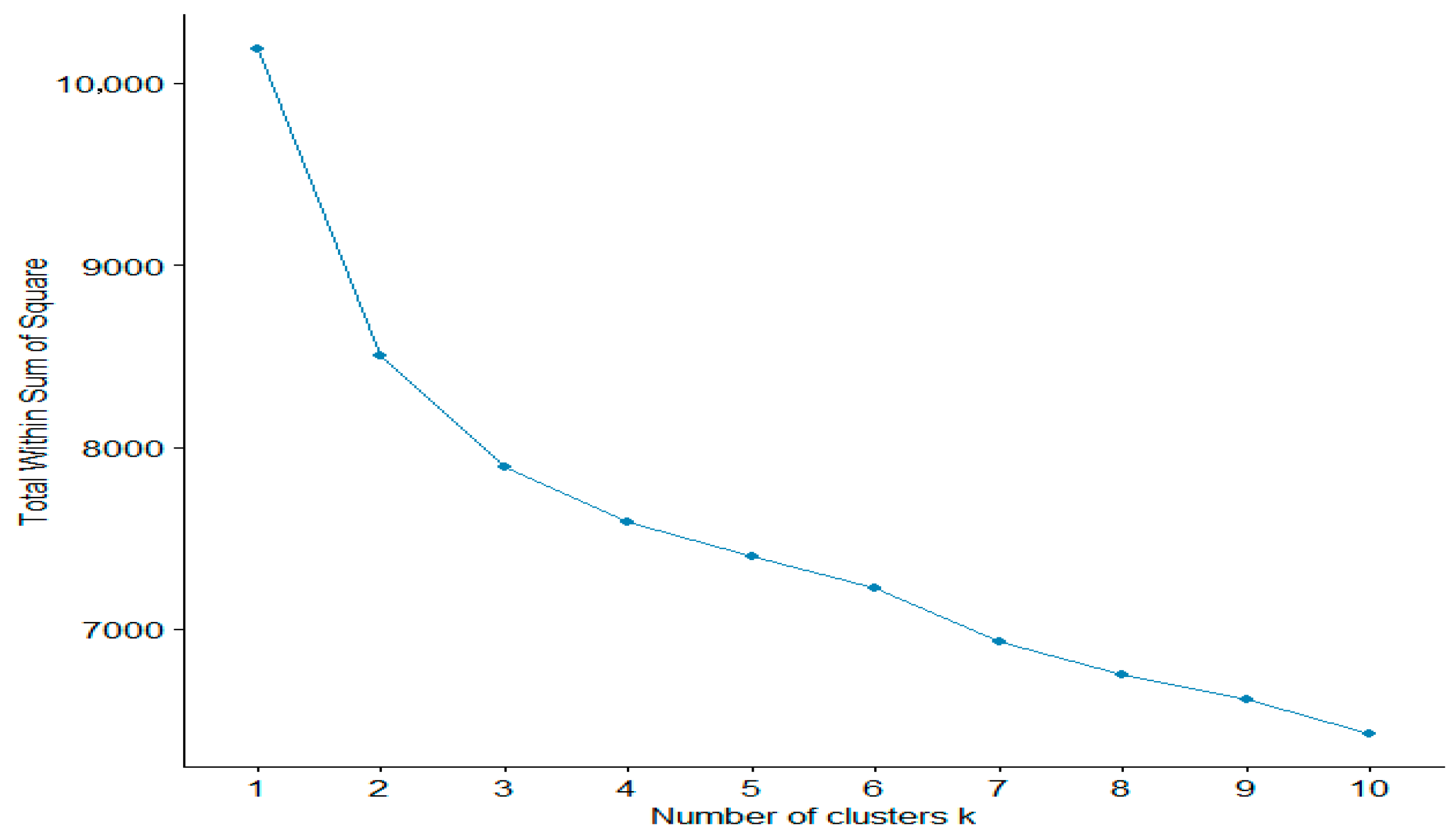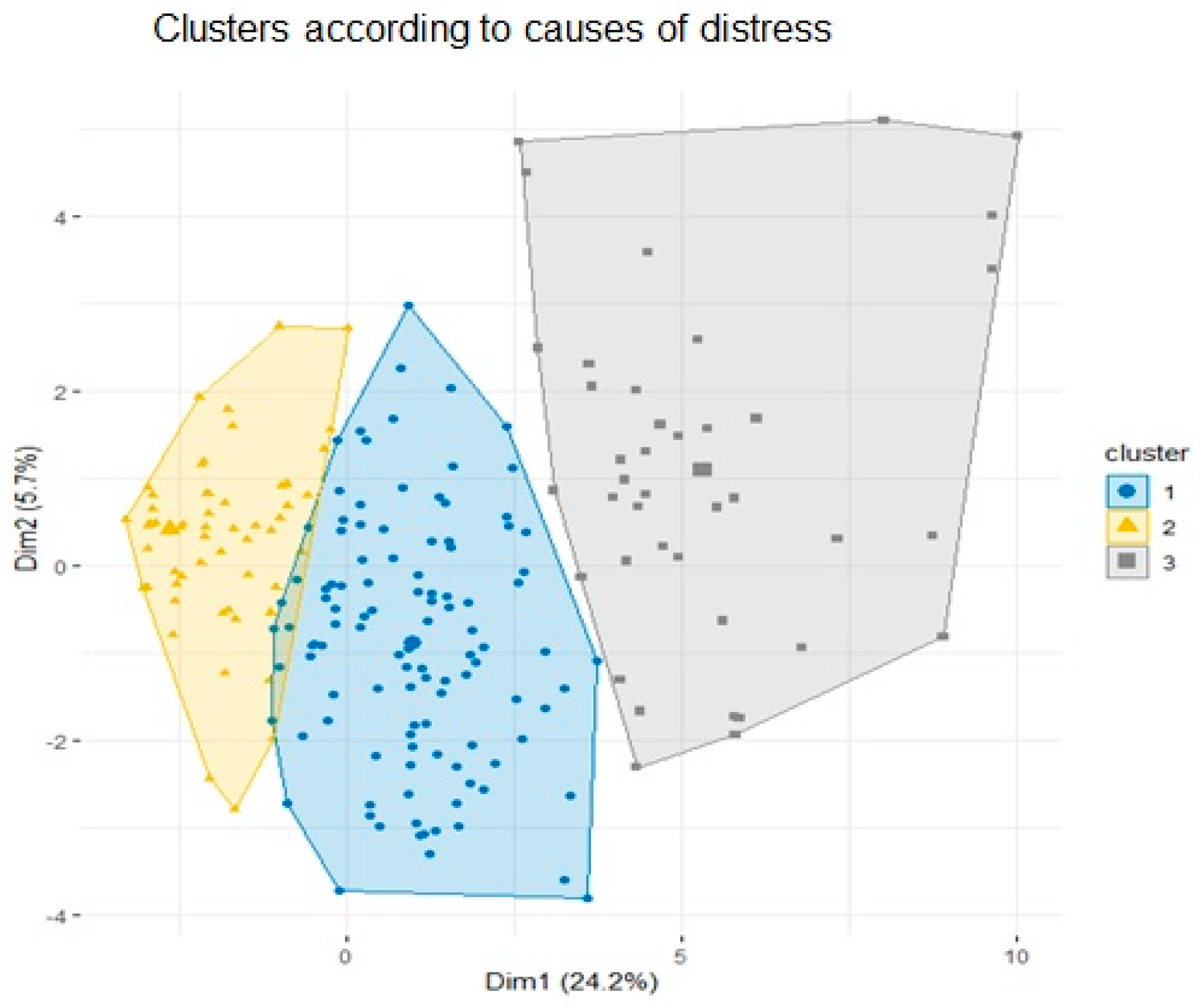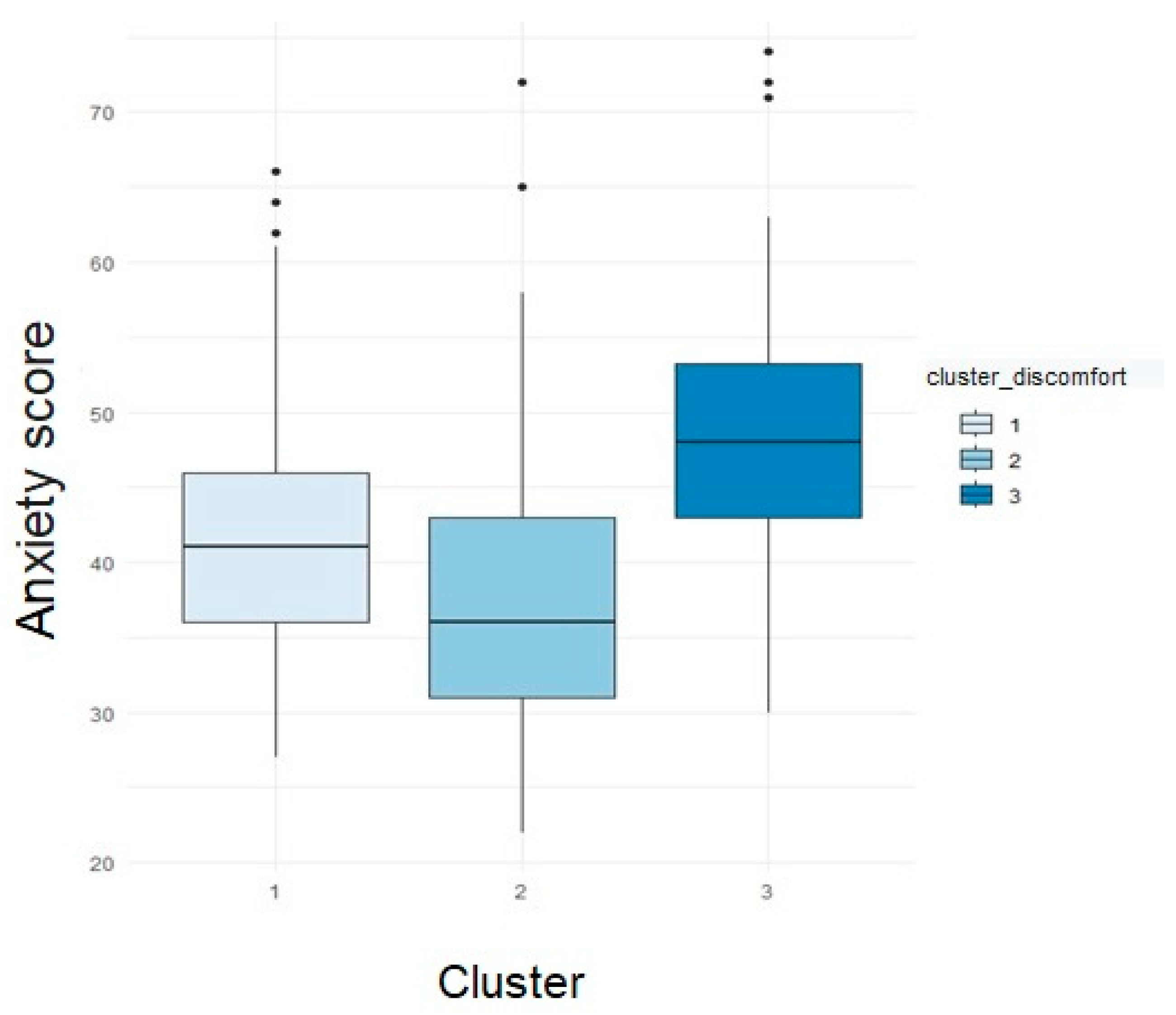Anxiety Levels in Teachers of Initial English Language Training in Ecuador
Abstract
1. Introduction
- What is the factor structure and reliability of the Zung Self-Report Anxiety Scale (SAS) among Ecuadorian pre-service English teachers?
- How are anxiety levels and stressors distributed across academic and personal contexts?
- What emotional risk profiles emerge from the 38 sources of contextual anxiety identified?
- To what extent do sociodemographic factors and stressors predict anxiety levels?
1.1. University Students’ Mental Health: A Growing Concern
1.2. Anxiety Assessment in Higher Education
1.3. Academic and Contextual Stressors in Higher Education
1.4. Multidimensional Approaches to Emotional Risk in Student Populations
2. Materials and Methods
2.1. The Sample
2.2. Instruments
2.2.1. The Zung Anxiety Self-Assessment Scale (SAS)
2.2.2. Survey of Causal Factors of Anxiety in Teacher Training
2.3. Procedure
2.3.1. Sample Selection (February 2024)
2.3.2. Data Collection Instrument Selection (March 2024)
2.3.3. Instrument Validation (April–May 2024)
2.3.4. Informed Consent
2.3.5. Instrument Administration (June 2024)
2.4. Data Analysis
2.4.1. Analysis of the Internal Structure and Consistency of the Zung Scale
2.4.2. Evaluation of the Internal Structure
2.4.3. Evaluation of Internal Consistency
2.4.4. Descriptive Analysis of Anxiety and Contextual Factors of Distress
2.4.5. Cluster Analysis (Clustering)
3. Results
3.1. Factor Structure and Reliability Analysis of the Zung Anxiety Self-Assessment Scale (SAS)
3.2. Descriptive Analysis of Anxiety and Contextual Factors of Distress
3.2.1. Distribution of Anxiety by Sex
3.2.2. Distribution of Anxiety by Age Group
3.2.3. Contextual Stressors Across Sociodemographic Subgroups
- The degree completion process (@3)—reported by 41.6% of participants, likely reflecting anxiety around graduation requirements and related administrative procedures;
- The certification process (@4), present in 34.9%, representing another formal academic demand;
- Fear of not finding a job after graduation (@5)—noted by 40.9%, underscoring concerns about post-graduation employment;
- Personal economic situation (@21)—reported by 27.9%, pointing to material hardship as a contributor to anxiety;
- To a lesser extent, parental relationship issues (@22), cited by 8.2%, potentially reflecting family conflict observed from the student’s perspective.
- Issues with academic authorities (@7)—reported by only 4.5%, suggesting minimal concern related to institutional management.
- Disinterest in the chosen career (@12)—4.8%, indicating low levels of vocational misalignment.
- Social pressure from friends (@25)—7.1%.
- Romantic relationships (@26)—8.2%).
- Current employment (@38)—11.5%, suggesting that relatively few students face emotionally distressing work conditions.
3.2.4. Distribution of Total Reported Stress Factors by Sex
3.2.5. Distribution of Total Reported Stress Factors by Age Group
3.3. Participants’ Emotional Risk Profiles
- -
- Cluster 1 (blue, dots) is the largest and most dispersed group, spanning a broad section of the horizontal axis. Its central concentration suggests a mixed profile, characterized by a moderate and varied presence of distress factors without a dominant pattern of accumulation or absence.
- -
- Cluster 2 (yellow, triangles) is positioned to the left of the factor space and displays a more compact structure. Its concentration in negative Dim1 values likely indicates a profile with a low number of distress factors, consistent with lower overall emotional risk.
- -
- Cluster 3 (gray, squares) appears on the right side of the graph and represents participants with a higher accumulation of distress factors, as indicated by their extreme position on Dim1. The expanded shape of this cluster reflects greater internal variability in the types and combinations of stressors reported.
3.4. Anxiety Levels According to Distress Clusters
- Cluster 1 shows a median anxiety score around 41, with moderate dispersion and a few outliers exceeding 60 points.
- Cluster 2 exhibits the lowest median (~35), indicating the lowest concentration of anxiety symptoms. This group also shows a higher density of cases in the lower quartiles, suggesting a profile of relatively low emotional vulnerability.
- Cluster 3, in contrast, has the highest median (~48) and a wider interquartile range, suggesting greater internal variability and heightened emotional vulnerability within the group. Extreme values further reflect the heterogeneous nature of this cluster.
4. Discussion
4.1. Discussion by Hypothesis
4.2. Integrative Discussion: Cross-Hypothesis Insights
4.3. Educational and Institutional Implications
5. Conclusions
Author Contributions
Funding
Institutional Review Board Statement
Informed Consent Statement
Data Availability Statement
Acknowledgments
Conflicts of Interest
References
- Adrianzén, C. S. (2021). Influencia de la ansiedad en el aprendizaje del idioma inglés como lengua extranjera en estudiantes de educación superior. INNOVA Research Journal, 6(3), 58–78. [Google Scholar] [CrossRef]
- Arnett, J. J. (2004). Emerging adulthood: The winding road from the late teens through the twenties. Oxford University Press. [Google Scholar]
- Ashqui, A., Zambrano, M., Vallejo, T., Figueroa, P., Salazar, R., & Alvarado, J. (2024). Influence of emotional health on academic performance in students of a higher education institution. LATAM Revista Latinoamericana de Ciencias Sociales y Humanidades, 5(2), 1154–1166. [Google Scholar] [CrossRef]
- Auerbach, R. P., Mortier, P., Bruffaerts, R., Alonso, J., Benjet, C., Cuijpers, P., Demyttenaere, K., Ebert, D. D., Green, J. G., Hasking, P., Murray, E., Nock, M. K., Pinder-Amaker, S., Sampson, N. A., Stein, D. J., Vilagut, G., Zaslavsky, A. M., & Kessler, R. C. (2016). WHO World mental health surveys international college student project: Prevalence and distribution of mental disorders. Journal of Abnormal Psychology, 127(7), 623–638. [Google Scholar] [CrossRef] [PubMed]
- Bakker, A. B., & Demerouti, E. (2007). The job demands–Resources model: State of the art. Journal of Managerial Psychology, 22(3), 309–328. [Google Scholar] [CrossRef]
- Beck, A. T., & Steer, R. A. (1993). Beck anxiety inventory manual. Psychological Corporation. [Google Scholar]
- Beiter, R., Nash, R., McCrady, M., Rhoades, D., Linscomb, M., Clarahan, M., & Sammut, S. (2015). The prevalence and correlates of depression, anxiety, and stress in a sample of college students. Journal of Affective Disorders, 173, 90–96. [Google Scholar] [CrossRef] [PubMed]
- Bronfenbrenner, U. (1979). The Ecology of Human Development: Experiments by Nature and Design. Harvard University Press. [Google Scholar] [CrossRef]
- Brougham, R. R., Zail, C. M., Mendoza, C. M., & Miller, J. R. (2009). Stress, sex differences, and coping strategies among college students. Current Psychology: A Journal for Diverse Perspectives on Diverse Psychological Issues, 28(2), 85–97. [Google Scholar] [CrossRef]
- Brown, T. A. (2015). Confirmatory factor analysis for applied research (2nd ed.). Guilford Press. [Google Scholar]
- Browning, M. H. E. M., Larson, L. R., Sharaievska, I., Rigolon, A., McAnirlin, O., Mullenbach, L., Cloutier, S., Vu, T. M., Thomsen, J., Reigner, N., Metcalf, E. C., D’Antonio, A., Helbich, M., Bratman, G. N., & Reigner, N. (2021). Psychological impacts from COVID-19 among university students: Risk factors across seven states in the United States. PLoS ONE, 16(1), e0245327. [Google Scholar] [CrossRef] [PubMed]
- Cairns, S. L., Massfeller, H. F., & Deeth, S. C. (2014). Why do post-secondary students seek counselling? Canadian Journal of Counselling and Psychotherapy, 44(1), 34–50. [Google Scholar]
- CASEL. (2020). The CASEL guide to schoolwide social and emotional learning. Collaborative for Academic, Social, and Emotional Learning (CASEL). Available online: https://casel.org/ (accessed on 12 April 2025).
- Cedeño, A., & Villafuerte-Holguín, J. (2024). Educación es la ruta para superar la violencia e inseguridad: Análisis de la novela “Los Sangurimas” de José de Cuadra. In Innovaciones pedagógicas para el desarrollo humano y sostenible (pp. 64–82). Mawil Ecuador. [Google Scholar] [CrossRef]
- Chamba, J. T. (2024). Inseguridad en Quevedo, Ecuador: Percepciones, influencias y repercusiones en la cotidianidad. Revista De Ciencias Sociales, (183), 101–118. [Google Scholar] [CrossRef]
- Chapell, M. S., Blanding, Z. B., Silverstein, M. E., Takahashi, M., Newman, B., Gubi, A., & McCann, N. (2005). Test anxiety and academic performance in undergraduate and graduate students. Journal of Educational Psychology, 97(2), 268–274. [Google Scholar] [CrossRef]
- Clerque Acuña, K. d. P., Díaz Villarruel, J. J., & Cabascango Vinueza, D. J. (2024). Depresión, ansiedad y estrés en estudiantes universitarios post covid 19 en la carrera de pedagogía de los idiomas nacionales y extranjeros (español—francés—inglés). LATAM Revista Latinoamericana de Ciencias Sociales y Humanidades, 5(4), 1069–1080. [Google Scholar] [CrossRef]
- Creswell, J. W., & Poth, C. N. (2016). Qualitative inquiry and research design: Choosing among five approaches. Sage Publications. [Google Scholar]
- De la Ossa, S., Martinez, Y., Herazo, E., & Campo, A. (2009). Study of internal consistency and factor structure of three versions of the Zung’s rating instrument for anxiety disorders. Colombia Médica, 40(1), 71–77. [Google Scholar] [CrossRef]
- Dunn, T. J., Baguley, T., & Brunsden, V. (2014). From alpha to omega: A practical solution to the pervasive problem of internal consistency estimation. British Journal of Psychology, 105(3), 399–412. [Google Scholar] [CrossRef]
- Dunstan, D. A., & Scott, N. (2020). Norms for Zung’s self-rating anxiety scale. BMC Psychiatry, 20(1), 90. [Google Scholar] [CrossRef]
- Dunstan, D. A., Scott, N., & Todd, A. K. (2017). Screening for anxiety and depression: Re-evaluating the utility of the Zung scales. BMC Psychiatry, 17, 329. [Google Scholar] [CrossRef] [PubMed]
- Eisenberg, D., Golberstein, E., & Gollust, S. E. (2009). Help-seeking and access to mental health care in a university student population. Medical Care, 47(3), 294–301. [Google Scholar] [CrossRef]
- Emiro Restrepo, J., Castañeda Quirama, T., & Zambrano Cruz, R. (2022). Sintomatología de depresión y ansiedad en estudiantes universitarios colombianos durante la pandemia covid-19. Ciencia y Enfermería, 28, 19–39. [Google Scholar] [CrossRef]
- Encalada, J., & Vega, M. (2024). Efecto de los factores socioeconómicos en la inseguridad social en Ecuador. Revista Ñeque, 7(18), 277–288. [Google Scholar] [CrossRef]
- Engel, G. L. (1977). The need for a new medical model: A challenge for biomedicine. Science, 196(4286), 129–136. [Google Scholar] [CrossRef] [PubMed]
- Fox, J., & Weisberg, S. (2019). An R companion to applied regression (3rd ed.). Sage. [Google Scholar]
- Ginevra, M. C., Pallini, S., Vecchio, G. M., Nota, L., & Soresi, S. (2016). Future orientation and attitudes mediate career adaptability and decidedness. Journal of Vocational Behavior, 95, 102–110. [Google Scholar] [CrossRef]
- Gkonou, C. (2017). Towards an ecological understanding of language anxiety. In C. Gkonou, M. Daubney, & J.-M. Dewaele (Eds.), New insights into language anxiety: Theory, research and educational implications (pp. 135–155). Multilingual Matters. [Google Scholar]
- Hu, L. T., & Bentler, P. M. (1999). Cutoff criteria for fit indexes in covariance structure analysis: Conventional criteria versus new alternatives. Structural Equation Modeling, 6, 1–55. [Google Scholar] [CrossRef]
- Hunt, J., & Eisenberg, D. (2010). Mental health problems and help-seeking behavior among college students. Journal of Adolescent Health, 46(1), 3–10. [Google Scholar] [CrossRef]
- Izurieta-Brito, D., Poveda-Ríos, S., Naranjo-Hidalgo, T., & Moreno-Montero, E. (2022). Trastorno de ansiedad generalizada y estrés académico en estudiantes universitarios ecuatorianos durante la pandemia COVID-19. Revista de Neuro-Psiquiatría, 85(2), 86–94. [Google Scholar] [CrossRef]
- Jorgensen, T. D., Pornprasertmanit, S., Schoemann, A. M., & Rosseel, Y. (2021). semTools: Useful tools for structural equation modeling (R package version 0.5-4). Available online: https://CRAN.R-project.org/package=semTools (accessed on 17 April 2025).
- Kassambara, A., & Mundt, F. (2020). factoextra: Extract and visualize the results of multivariate data analyses (R package version 1.0.7). Available online: https://CRAN.R-project.org/package=factoextra (accessed on 1 April 2025).
- Khoshaim, H. B., Al-Sukayt, A., Chinna, K., Nurunnabi, M., Sundarasen, S., Kamaludin, K., Baloch, G. M., & Hossain, S. F. A. (2020). Anxiety level of university students during COVID-19 in Saudi Arabia. Frontiers in Psychiatry, 11, 579750. [Google Scholar] [CrossRef] [PubMed]
- Kline, R. B. (2016). Principles and practice of structural equation modeling (4th ed.). Guilford Press. [Google Scholar]
- Levecque, K., Anseel, F., De Beuckelaer, A., Van der Heyden, J., & Gisle, L. (2017). Work organization and mental health problems in PhD students. Research Policy, 46(4), 868–879. [Google Scholar] [CrossRef]
- Li, C. H. (2016). Confirmatory factor analysis with ordinal data: Comparing robust maximum likelihood and diagonally weighted least squares. Behavior Research Methods, 48(3), 936–949. [Google Scholar] [CrossRef] [PubMed]
- Liu, M., & Jackson, J. (2008). An exploration of Chinese EFL learners’ unwillingness to communicate and foreign language anxiety. The Modern Language Journal, 92(1), 71–86. [Google Scholar] [CrossRef]
- Misra, R., & McKean, M. (2000). College students’ academic stress and its relation to their anxiety, time management, and leisure satisfaction. American Journal of Health Studies, 16(1), 41–51. [Google Scholar]
- Morán Murillo, G. A., Amaiquema Márquez, F. A., Vera Zapata, J. A., & Landívar Morán, G. E. (2024). Medición de la ansiedad en población ecuatoriana una revisión sistemática. Revista Pertinencia Académica. [Google Scholar] [CrossRef]
- Moreta-Herrera, R., Zambrano-Estrella, J., Sánchez-Vélez, H., & Naranjo-Vaca, S. (2021). Salud mental en universitarios del Ecuador: Síntomas relevantes, diferencias por género y prevalencia de casos. Pensamiento Psicológico, 19(1), 1–26. [Google Scholar] [CrossRef]
- Nguyen, H. T., Do, B. N., Pham, K. M., Kim, G. B., Dam, H. T., Nguyen, T. T., Nguyen, T. T. P., Nguyen, Y. H., Sørensen, K., Pleasant, A., & Duong, T. V. (2021). Fear of COVID-19 scale—Associations of its scores with health literacy and health-related behaviors among medical students. International Journal of Environmental Research and Public Health, 18(8), 4164. [Google Scholar] [CrossRef] [PubMed]
- Nunnally, J. C., & Bernstein, I. H. (1994). Psychometric theory (3rd ed.). McGraw-Hill. [Google Scholar]
- Ordorika, I., & Rodríguez-Gómez, R. (2020). Field of higher education research in Latin America. In P. N. Teixeira, & J. C. Shin (Eds.), The International Encyclopedia of Higher Education Systems and Institutions (pp. 437–443). Springer. [Google Scholar] [CrossRef]
- Owens, M., Stevenson, J., Hadwin, J. A., & Norgate, R. (2012). Anxiety and depression in academic performance: An exploration of the mediating factors of worry and working memory. School Psychology International, 33(4), 433–449. [Google Scholar] [CrossRef]
- Palma-Delgado, G. M., & Barcia-Briones, M. F. (2020). El estado emocional en el rendimiento académico de los estudiantes en Portoviejo, Ecuador. Dominio De Las Ciencias, 6(2), 72–100. [Google Scholar]
- Paulhus, D. L., & Vazire, S. (2007). The self-report method. Handbook of research methods in personality psychology, 1(2007), 224–239. [Google Scholar]
- R Core Team. (2023). R: A language and environment for statistial computing. R Foundation for Statistical Computing. [Google Scholar]
- Revelle, W., & Zinbarg, R. E. (2009). Coefficients alpha, beta, omega, and the glb: Comments on Sijtsma. Psychometrika, 74(1), 145–154. [Google Scholar] [CrossRef]
- Robotham, D. (2008). Stress among higher education students: Towards a research agenda. Higher Education, 56(6), 735–746. [Google Scholar] [CrossRef]
- Rosseel, Y. (2012). Lavaan: An R package for structural equation modeling. Journal of Statistical Software, 48(2), 1–36. [Google Scholar] [CrossRef]
- Ruiz-Segarra, M. I. (2021). Ansiedad ante exámenes y hábitos de estudio en educación superior. Horizontes. Revista De Investigación En Ciencias De La Educación, 4(16), 461–468. [Google Scholar] [CrossRef]
- Salmela-Aro, K., & Upadyaya, K. (2014). School burnout and engagement in the context of demands–resources model. British Journal of Educational Psychology, 84(1), 137–151. [Google Scholar] [CrossRef]
- Salovey, P., Woolery, A., & Mayer, J. D. (2001). Emotional intelligence: Conceptualization and measurement. In Blackwell handbook of social psychology: Interpersonal processes (pp. 279–307). Blackwell Publishers Ltd. [Google Scholar]
- Saravanan, C., & Wilks, R. (2014). Medical students’ experience of and reaction to stress: The role of depression and anxiety. The Scientific World Journal, 2014(1), 737382. [Google Scholar] [CrossRef]
- Schaufeli, W. B., Bakker, A. B., & Van Rhenen, W. (2009). How changes in job demands and resources predict burnout, work engagement, and sickness absenteeism. Journal of Organizational Behavior, 30(7), 893–917. [Google Scholar] [CrossRef]
- Schwartzman, S. (2020). Higher education in Latin America and the challenges of the 21st century. In S. Schwartzman (Ed.), Higher education in Latin America in the 21st century (pp. 1–17). Springer. [Google Scholar] [CrossRef]
- Son, C., Hegde, S., Smith, A., Wang, X., & Sasangohar, F. (2020). Effects of COVID-19 on college students’ mental health in the United States: Interview survey study. Journal of Medical Internet Research, 22(9), e21279. [Google Scholar] [CrossRef]
- Spielberger, C. D. (1983). Manual for the state-trait anxiety inventory (STAI). Consulting Psychologists Press. [Google Scholar]
- Taylor, S. (2014). Anxiety sensitivity: Theory, research, and treatment of the fear of anxiety (2nd ed.). Routledge. [Google Scholar]
- Vázquez, J. M. H., Lagunas, J. R., & Piña, M. A. L. (2021). Inseguridad escolar y problemas académicos en una universidad pública mexicana. Revista de Investigación Educativa de la REDIECH, 12, e1114. [Google Scholar] [CrossRef]
- Velásco, R. J., Cunalema, J. A., Franco, J. A., & Vargas, G. M. (2021). Estrés percibido asociado a la pandemia por COVID-19 en la ciudad de Guayaquil, Ecuador. Bol. malariol. Salud Ambient, 3, 38–46. Available online: https://docs.bvsalud.org/biblioref/2021/04/1177559/art-2-i-2021.pdf (accessed on 11 April 2025).
- Verger, P., Combes, J. B., Kovess-Masfety, V., Evangelista, J. A., Guagliardo, V., Rouillon, F., & Peretti-Watel, P. (2019). Psychological distress in first-year university students: Socioeconomic and academic stressors, mastery and social support in young men and women. Social Psychiatry and Psychiatric Epidemiology, 44(8), 643–650. [Google Scholar] [CrossRef]
- Villafuerte-Holguín, J., Bello Piguave, J., Pacheco Delgado, E., & Zavala-Alcivar, A. (2023). Ansiedad y resiliencia laboral en la acreditación de docentes de inglés. Profesorado: Revista de Currículum y Forma-ción del Profesorado, 27(1), 229–253. [Google Scholar]
- Wickham, H. (2016). ggplot2: Elegant graphics for data analysis. Springer. Available online: https://ggplot2.tidyverse.org (accessed on 5 July 2025).
- Wickham, H., François, R., Henry, L., & Müller, K. (2023). dplyr: A grammar of data manipulation (R package version 1.1.2). Available online: https://CRAN.R-project.org/package=dplyr (accessed on 10 January 2025).
- World Health Organization. (2022). World mental health report: Transforming mental health for all. WHO. Available online: https://www.who.int/publications/i/item/9789240049338 (accessed on 11 April 2025).
- Yánez Yánez, M. G. (2023). Ansiedad y rendimiento académico en estudiantes de la escuela de medicina de la PUCESA. Available online: https://repositorio.puce.edu.ec/handle/123456789/45343 (accessed on 12 April 2025).
- Zhao, H., Rafik-Galea, S., Fitriana, M., & Song, T.-J. (2022). Translation and psychometric evaluation of Smartphone Addiction Scale—Short Version (SAS-SV) among Chinese college students. PLoS ONE, 17(11), e0278092. [Google Scholar] [CrossRef] [PubMed]
- Zung, W. W. K. (1965). A self-rating depression scale. Archives of General Psychiatry, 12(1), 63–70. [Google Scholar] [CrossRef]
- Zung, W. W. K. (1971). A rating instrument for anxiety disorders. Psychosomatics, 12(6), 371–379. [Google Scholar] [CrossRef]





| Model | χ2 (gl) | IFC | TLI | RMSEA | SRMR |
|---|---|---|---|---|---|
| One-dimensional | 248.63 (170) | 0.978 | 0.975 | 0.039 | 0.054 |
| Bifactor (2 factors) | 244.54 (169) | 0.979 | 0.976 | 0.038 | 0.053 |
| Second order (2 + 1) | 147.94 (168) | 0.999 | 0.998 | 0.000 | 0.053 |
Disclaimer/Publisher’s Note: The statements, opinions and data contained in all publications are solely those of the individual author(s) and contributor(s) and not of MDPI and/or the editor(s). MDPI and/or the editor(s) disclaim responsibility for any injury to people or property resulting from any ideas, methods, instructions or products referred to in the content. |
© 2025 by the authors. Licensee MDPI, Basel, Switzerland. This article is an open access article distributed under the terms and conditions of the Creative Commons Attribution (CC BY) license (https://creativecommons.org/licenses/by/4.0/).
Share and Cite
Bello Piguave, J.E.; Idoiaga-Mondragon, N.; Villafuerte Holguin, J.S.; Garagarza, A.; Alonso, I. Anxiety Levels in Teachers of Initial English Language Training in Ecuador. Educ. Sci. 2025, 15, 972. https://doi.org/10.3390/educsci15080972
Bello Piguave JE, Idoiaga-Mondragon N, Villafuerte Holguin JS, Garagarza A, Alonso I. Anxiety Levels in Teachers of Initial English Language Training in Ecuador. Education Sciences. 2025; 15(8):972. https://doi.org/10.3390/educsci15080972
Chicago/Turabian StyleBello Piguave, Johanna Elizabeth, Nahia Idoiaga-Mondragon, Jhonny Saulo Villafuerte Holguin, Aitor Garagarza, and Israel Alonso. 2025. "Anxiety Levels in Teachers of Initial English Language Training in Ecuador" Education Sciences 15, no. 8: 972. https://doi.org/10.3390/educsci15080972
APA StyleBello Piguave, J. E., Idoiaga-Mondragon, N., Villafuerte Holguin, J. S., Garagarza, A., & Alonso, I. (2025). Anxiety Levels in Teachers of Initial English Language Training in Ecuador. Education Sciences, 15(8), 972. https://doi.org/10.3390/educsci15080972









